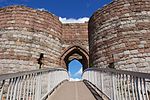Peckforton

Peckforton is a scattered settlement (centred at SJ538564) and civil parish in the unitary authority of Cheshire East and the ceremonial county of Cheshire, England. The settlement is located 6.5 miles (10.5 km) to the north east of Malpas and 7.5 miles (12.1 km) to the west of Nantwich. The civil parish covers 1,754 acres (710 ha), with an estimated total population of 150 in 2006. The area is predominantly agricultural. Nearby villages include Bulkeley to the south, Beeston to the north, Higher Burwardsley to the west, Spurstow to the east and Bunbury to the north east. The Peckforton Hills form the western part of the civil parish with high points at Peckforton Point (203 metres) and Stanner Nab (200 metres). They are the source of the Weaver and Gowy rivers. Part of Peckforton Woods, largely planted in 1922, form a Site of Special Scientific Interest. The hills have been quarried since the Roman era. Peckforton appears in the Domesday survey of 1086. The earliest surviving buildings date from the early 17th century. Peckforton and the adjacent Beeston were part of an estate purchased by John Tollemache, Lord Tollemache in 1840. He had Peckforton Castle – a Victorian mansion designed by Anthony Salvin in imitation of a medieval castle – built at the northern end of the Peckforton ridge. Many of the local buildings were constructed for Lord Tollemache using brick in the 1860s and 1870s as part of the Peckforton Estate.
Excerpt from the Wikipedia article Peckforton (License: CC BY-SA 3.0, Authors, Images).Peckforton
Peckforton Hall Lane,
Geographical coordinates (GPS) Address Nearby Places Show on map
Geographical coordinates (GPS)
| Latitude | Longitude |
|---|---|
| N 53.102952 ° | E -2.689385 ° |
Address
Peckforton Hall Lane
Peckforton Hall Lane
CW6 9TH
England, United Kingdom
Open on Google Maps









